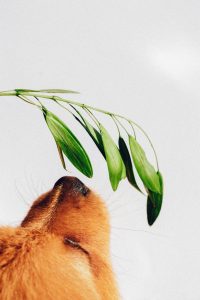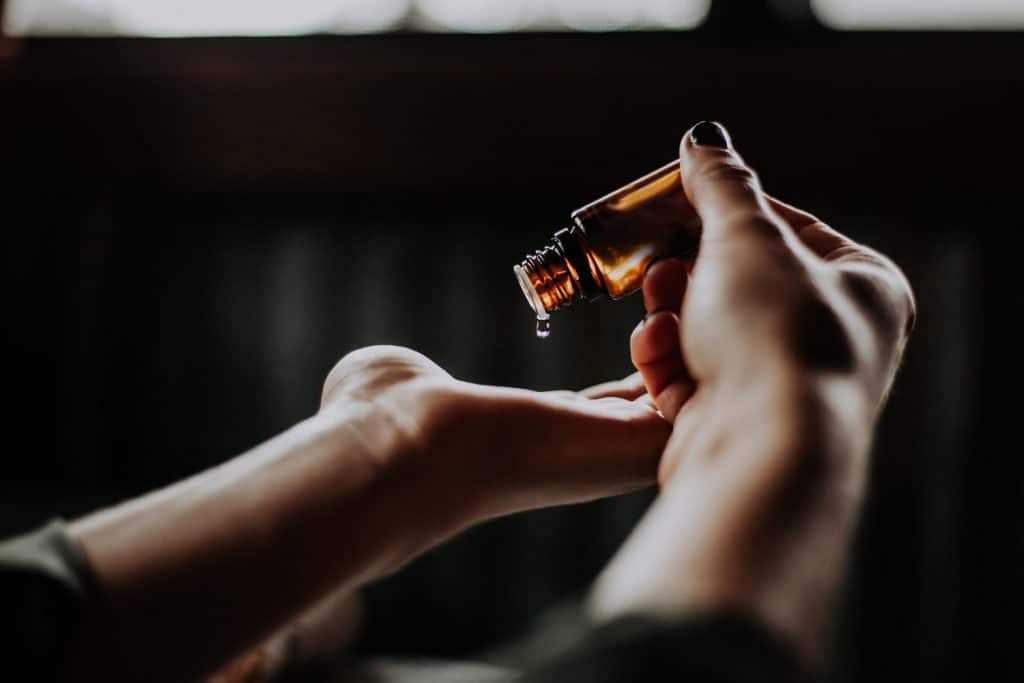There are three main considerations when considering which Essential Oils are safe for your dog.
- Toxicity
- Quality
- Concentration (Dilution)
1. Toxicity
Quite simply, there are some plants, if ingested, that are toxic or poisonous for dogs. But so is chocolate right?
My point is that soundly educating ourselves about the specific substances that are toxic or poisonous for our pets is a responsible pet owner’s obligation to our pet, no matter how innocuous the substances may seem.
It is a common misconception that substances are considered to be safe just because they are natural, but that is most definitely not the case. Nor is it true that just because regular, everyday items are readily available from supermarket or pharmacy shelves that they are free from danger or toxicity for our pets either.
So please do a bit of research, gain a balanced view and assess the substances in and around your home – for the safety of your pet and for you.
When it comes to Essential Oils and toxicity for our dogs, there is a list of oils we recommend avoiding – simply for your peace of mind. In individual cases, under the supervision of a qualified Aromatherapist, small amounts of them are fine, but these Essential Oils are very strong, very “hot” and highly sensitising. As a qualified and professional Aromatherapist, we do not even use the vast majority of them – for exactly these reasons. We find them too hot and sensitising for our human use.
AND because in the world of Aromatherapy, we are so blessed with variety, there is usually a gentler, equally effective and less stressful to use substitute available. So substitute any guesswork and worry with good research and gentle alternatives and you and your pet will be healthier and happier.
Afterall, if what we are doing with our use of Aromatherapy is harming our pets and us, then we have totally missed the point of Aromatherapy right?!
For stress free use of Essential Oils with your dog, you may as well just avoid these:
| Anise | Mugwort |
| Birch | Mustard |
| Bitter Almond | Oregano |
| Boldo | Pennyroyal |
| Calamus | Red/White Thyme |
| Camphor | Rue |
| Cassia | Santalina |
| Chenopodium | Sassafras |
| Clove Leaf and bud | Savoury |
| Crested Lavender | Tansy |
| Garlic | Terebinth |
| Goosefoot | Thuja |
| Horseradish | Wintergreen |
| Hyssop | Wormwood |
| Juniper | Yarrow |
(Holistic Aromatherapy for Animals, K. L. Bell, 2002)
So which Essential Oils can I use with my dog then?
Because it is well resourced and put together by a passionate professional, we like this list compiled by Aromatherapist and ambassador for using Essential Oils Safely, Lea Jacobson.
- Angelica Root Angelica archangelica
- Basil (linalool chemotype) Ocimum basilicum ct. linalool
- Bergamot Citrus bergamia, Citrus aurantium subspecies bergamia
- Black Pepper Piper nigrum
- Cajeput Melaleuca cajuputi
- Caraway Carum carvi
- Cardamom Elatteria cardamomum
- Carrot Seed Daucus carota, Daucus carota subspecies sativa
- Cedarwood (Atlas) Cedrus atlantica
- Chamomile (German) Matricaria chamomilla, Matricaria recutita, Chamomilla recutita
- Chamomile (Roman) Anthemis nobilis, Chamaemelum nobile
- Cinnamon Leaf Cinnamomum verum, Cinnamomum zeylanicum
- Cistus Cistus ladanifer, Cistus ladaniferus
- Citronella Cymbopogon winterianus, Cymbopogon nardus
- Coriander Coriandrum sativum
- Cypress Cupressus sempervirens
- Elemi Canarium luzonicum, Canarium vulgare
- Eucalyptus Eucalyptus radiata (this is the species specified, but the other species have the same safety issues)
- Fennel (Sweet) Foeniculum vulgare
- Frankincense Boswellia carterii
- Geranium Pelargonium graveolens, Pelargonium x asperum
- Ginger Zingiber officinale
- Grapefruit Citrus paradisi
- Helichrysum Helichrysum
- Juniper Berry Juniperus communis
- Lavender Lavender angustifolia, Lavender officinalis
- Lemon Citrus limon, Citrus limonum
- Lemongrass Cymbopogon flexuosus, Andropogon flexuosus, Cymbopogon citratus, Andropogon citratus
- Mandarin Citrus reticulata, Citrus nobilis
- Marjoram (Sweet) Origanum marjorana, Marjorana hortensis, Origanum dubium
- Melissa Melissa officinalis
- Myrrh Commiphora myrrha, Commiphora molmol
- Neroli Citrus x aurantium
- Niaouli Melaleuca quinquinervia
- Nutmeg Myristica fragrans, Myristica moschata, Myristica aromatica, Myristica amboinensis
- Opopanax Commiphora erythraea, Commiphora guidottii
- Orange (Sweet, Blood) Citrus sinensis, Citrus aurantium var. sinensis
- Palmarosa Cymbopogon martinii, Andropogon martinii var martinii, Cymbopogon martinii var motia
- Patchouli Pogostemon cablin, Pogostemon patchouly
- Peppermint Mentha piperita
- Petitgrain Citrus aurantium
- Plai Zingiber cassumunar, Zingiber montanum, Amomum montanum, Zingiber purpureum
- Rosalina Melaleuca ericifolia
- Rose (Bulgarian, Damask) Rosa damascena
- Rosemary Rosmarinus officinalis
- Sandalwood Santalum spicatum, Santalum album
- Spearmint Mentha spicata, Mentha cardiaca, Mentha crispa, Mentha viridis
- Spikenard Nardostachys grandiflora
- Tangerine Citrus reticulata, Citrus nobilis, Citrus tangerine
- Tea Tree Melaleuca
- Thyme (linalool chemotype) Thymus vulgaris ct. linalool
- Valerian Valeriana officinalis
- Vanilla Vanilla planifolia, Vanilla fragrans, Vanilla tahitensis
- Vetiver Vetiveria zizanoides, Andropogon muricatus, Andropogon zizanoides, Chrysopogon zizanoides, Phalaris zizanoides
- Yarrow Achillea millefolium
- Ylang Ylang Cananga odorata, Cananga odorata genuina

We’d also like to tell you about this handy website about toxic plants for dogs and cats.
It is a handy reference for all pet owners and was the very starting point for formulating our blends. It provides a non-exhaustive but very expansive list of plants (and the parts of them) that are toxic to animals if ingested.
We figure that if our pets’ health is negatively impacted by ingesting the substance, then care should be taken with its topical use too. Afterall the skin absorbs 60-70% of everything we put on it and in less than 30 seconds, so we have adopted, as a general safety rule, if it’s ok to ingest then it’s ok to put on our skin and into the air around us.
Remember!
There are exceptions to every rule. So just keep an eye on your furry friend whenever you are trying something new, whether it be Essential Oils or floor cleaner. Assess them for negative, neutral and positive responses and go from there.
2. Quality
Once you have sorted out the Essential Oils you want to comfortably and safely utilise with your dog, you MUST then source THE best quality oils you can afford. Otherwise, you run the risk of using adulterated oils.
Because the perfume and food industries are by far the biggest user of Essential Oils and their needs are focused on creating consistent and homogenous fragrances and flavours year in year out, there ends up being high volumes of adulterated oils on the market i.e. oils that have had their most precious constituents cherry picked and so, their therapeutic value diluted.
And then there are the more unscrupulous traders who simply dilute pure Essential Oils with something else to stretch it out i.e. make the valuable pure oil go further for a greater financial return by adding something else and usually cheaper (and sometimes nastier) to it.
For the unqualified and inexperienced, it is often really hard to tell the difference between an adulterated and a pure Essential Oil just by smelling it. So unless you have ready access to Gas Chromatography Testing (GC Testing), the source of your Essential Oils becomes vital.
Our Essential Oils are sourced from a small, family run business, which for almost 30 years, has been a health, and specifically Aromatherapy institution on the beautiful Gold Coast, Queensland, Australia. For our Essential Oil traders, purity, ethical sourcing and sustainability are their top priorities when it comes to Essential Oils. Our relationship with these good souls spans almost 20 years and so as part of the Genki Pet Community, you not only benefit from our experience and expertise, you benefit from the experience and expertise of the industry connections we have made and nurtured over the years.
Q: So what happens if you just use that Eucalyptus oil in the clear bottle from off the shelves at Coles or Woolies?
Well – you simply do not get what you think you are getting.
Any Essential Oil in a clear bottle has begun oxidising for a start! (Always choose amber bottles).
Q: And so what if some constituents of the whole oil have been pilfered by perfumers?
Well – just like a cake missing one of the three eggs it was meant to have according to the recipe, your adulterated oil will be different from the whole, pure and unadulterated oil and not quite right.
At best, it just may not have all the therapeutic benefits you need or want for your purpose. At worst, the adulterated oil may have added synthetic components, or it may be missing its natural constituents that Shirley Price in her best seller, The Aromatherapy Workbook, refers to as “quenchers”:
When science removes the therapeutic molecules or components from plants or Essential Oils, the administered result seems to give side effects (that the whole oil does not). In the whole plant or whole Essential Oil, there are “apparently useless” components, including several we cannot identify. These are believed to be ‘quenchers’ of the side effects which therapeutic agents in isolation could, and indeed do, cause.
One excellent example is Cinnamon Bark Oil. Cinnamic aldehyde, a major constituent in this oil, was found to be a severe irritant. However, the complete oil, when tested, was found to be an irritant only on certain people and to a much lesser degree. The other components or constituents of the whole oil were quenching the irritant qualities of the aldehyde. (p25)
So stick with whole, pure and unadulterated Essential Oils and leave your pet’s health up to Mother Nature. We think she knows best!
3. Concentration (Dilution)
This is the uncomplicated part of the safe use of Essential Oils with dogs! 
Our dogs’ sense of smell is 50 times greater than ours.
So do the math and adjust your concentration of oils accordingly.
Our blends are dialled right down for our dog and cat customers and they still smell amazing to humans and are super effective for dogs, cats and humans.
Like we always say:
Why use a fire hose to clean the house when a feather duster will do?
And always remember!
Ventilation amplifies or reduces the effects of Essential Oil concentration, so make sure your dog and mode of Aromatherapy share a room with an open door or window.
And all Essential Oils must be DILUTED for use with dogs, cats (and Humans for best practice).




